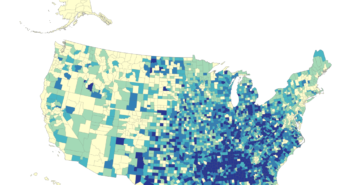Introduction
The American Community Survey recently released its most up to date data for every county in America. With release there were estimates on the what the median cost of rent was for every county in the US for 2010-2014. Below you are able to find visualizations representing that data, along with links to interactive versions of these graphics.
Visualizations
Want to take a closer look or utilize the filters? Click here to view an interactive version of this visualization.
The interactive version of this visualization with individual information about each county is located here.
Quick Analysis
Like the data on median income that was posted earlier this week, there are no real shockers here. It appears that median rent is high where you would expect it to be high and low where you would expect it to be low. Metro areas continue to have higher rent that that of rural communities. This is most likely accompanied by a higher median income.
This could be useful information though in determining what areas to live around certain metro areas. The interactive version of the map and whisker plot can let you take a closer look at individual counties.
It is interesting to note the wide variances between counties and some states. Some states have large ranges such as California, Maryland, Massachusetts and Virginia. Others though have very small ranges like Delaware, Indiana, New Jersey, and Rhode Island. This is most likely influenced by the number of counties in that state as well as differences in the size of the counties in that state. Further research would need to be done to confirm though.
If you have any thoughts or analysis you would like to share, be sure to share it below.
If you are interested in further visualizations, check out how the median rent compares with the median income in each county.
Source
The data for this visualization comes from the American Community Survey with is conducted by the United States Census Bureau. The data set can be found at http://factfinder.census.gov. It is labeled, Median Gross Rent (Dollars), Table B25064. The 2010-2014 5 Year Estimates were used in an effort to provide information on every county. The visualization is representative of data collected in that time period.
Once the data was downloaded it was manipulated in Microsoft Excel. It was loaded into Tableau where I rendered the visualizations and added filters.




1 Comment
From the NJ.com Hudson County Voices:I was very dismayed, aenergd and frustrated to read that Mayor Healy and Jersey City’s council are considering raising property taxes twice during the same fiscal year. It is very disturbing and frustrating to watch the apparent ease with which our elected officials increase our property tax levels. It is insulting to the hardworking Jersey City residents, many who will have to make significant sacrifices to be able to live in this beautiful city. The electorate trusted and elected you after their careful deliberation. But it seems that you vote for tax increases with ease, without any deliberation, and without any effort push a heavier financial burden to already suffering Jersey City residents.Currently, our nation is in a deep recession, an economic calamity comparable to the Great Depression. In New Jersey, nearly 10 percent are unemployed. In Hudson County, the numbers are similar. Ten percent of your residents do not have jobs, yet this city’s elected leaders cannot seem to take this into consideration when creating a budget. Raising taxes will make their daily struggle even more difficult.My family is very lucky in that both my husband and I have been able to keep our jobs during the recession. But we have not seen any pay raises, bonuses, or other increases in our income. Moreover, we own a multifamily rental building. Last year, we were forced to reduce our rents to keep it occupied, we also have had tenants facing severe economic hardship. As a result of these factors, our income has decreased in real terms; expenses beyond our control have increased, unfortunately.Last year, we have had a significant 11.25 percent property tax increase, which amounts to more than $2,500 a year of additional expenses. This year, our water/sewage rates increased by 25 percent, which will increase our expenses approximately another $300-400 this year we even work with our tenants on water conservation. Learning that you are considering another substantial tax increase, which for us will be more than $1,600 a year, is very difficult to hear. Compared to one year ago, these increased taxes have cut into our daily living expenses by more than $4,500. As a result of these increases, we had to dramatically decrease our contribution to our child’s college fund, our retirement accounts, and any improvements we would like to make to maintain our building, our tenants, and improve our city.